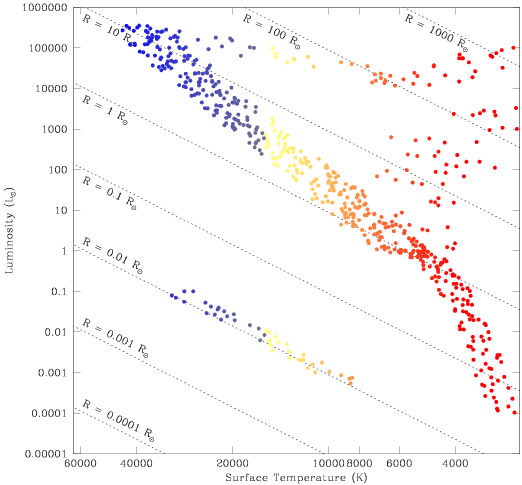

Place the cursor on a region filled by stars on the figure above, and click with your mouse. A separate browser window will appear with information about stars found in that region of the Hertzsprung-Russell diagram. You should be able to estimate the luminosity, temperature, and radius of these stars by eye by reading the diagram. If you know the value of two of these three quantities exactly, you can calculate a specific value for the third as well.
You can read off the temperature of a star by tracing a line down from the cursor to the x-axis. (The x-axis is the line drawn on the bottom of the figure, running from the hottest temperatures of 60,000 K on the left over to the coldest temperatures of 4,000 K on the right.) Find the point along this line which falls below the cursor: this will tell you the approximate temperature of the stars found in the region of the Hertzsprung-Russell diagram that you have selected.
Next, you can read off the luminosity (or brightness) of the star by tracing a line over to the left from the cursor to the y-axis. (The y-axis is the line drawn on the left hand side of the figure, running from the faintest luminosities at 0.00001 L_sun on the bottom up to the brightest luminosities at 1,000,000 L_sun on the top.) Find the point along this line which falls to the left the cursor: this will tell you the approximate luminosity of the stars found in the region of the Hertzsprung-Russell diagram that you have selected.
Finally, you can read off the radius (or size) of the star. There are eight diagonal lines running across the image, labeled R = 0.0001 R_sun (bottom left corner) to R = 1,000 R_sun (upper right corner). Find the line which is nearest to the cursor: this will tell you the approximate size of the stars found in the region of the Hertzsprung-Russell diagram that you have selected.
Place your cursor along the Main Sequence, or in the region where giant stars or white dwarfs are found, and try to read the values of L, T, and R for yourself from the diagram. Then calculate specific values for the luminosity, temperature, and size of the star, by assuming values for two of the three quantities.